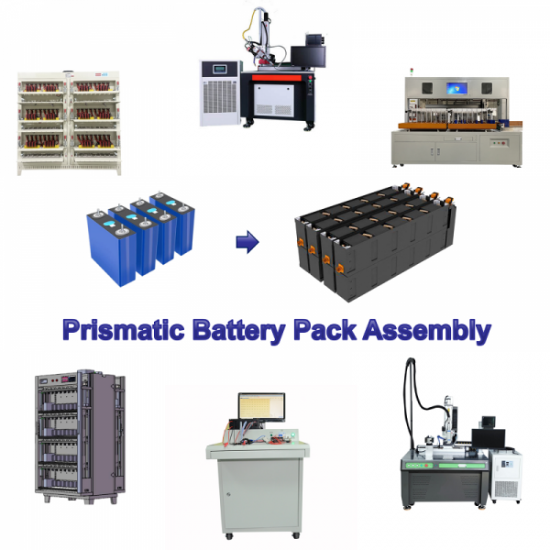Lith Corporation, founded in 1998 by a group of material science doctor from Tsinghua University, has now become the leading manufacturer of battery lab&production equipment. Lith Corporation have production factories in shenzhen and xiamen of China.This allows for the possibility of providing high quality and low-cost precision machines for lab&production equipment,including: roller press, film coater,mixer, high-temperature furnace, glove box,and complete set of equipment for research of rechargeable battery materials. Simple to operate, low cost and commitment to our customers is our priority.
What is a LiFePO₄ Prismatic Cell Production Line?
A LiFePO₄ (Lithium Iron Phosphate) Prismatic Cell Production Line is a fully integrated manufacturing system designed to produce prismaticshaped lithiumion battery cells using LiFePO₄ chemistry as the cathode material.
These production lines are used to massproduce highquality, highsafety battery cells that are widely adopted in:
Electric Vehicles (EVs) – Passenger cars, commercial vehicles, buses
Energy Storage Systems (ESS) – Gridscale storage, renewable integration, backup power
Industrial Applications – Forklifts, AGVs (autonomous guided vehicles), mining equipment
Marine and Rail Transport – Electric boats, trains, and ships
Prismatic cells are rigid, rectangularshaped batteries typically housed in aluminum or steel casings, offering structural stability, modular design, and excellent thermal safety—especially when using LiFePO₄, which is known for its inherent stability and long cycle life.
Why LiFePO₄ for Prismatic Cells?
LiFePO₄ is a preferred cathode material for prismatic cell production due to its:
High thermal and chemical stability – significantly reduces the risk of thermal runaway
Long cycle life – up to 5,000–10,000 cycles under proper conditions
Good safety performance – even under abuse conditions (overcharge, short circuit, high temperature)
Moderate energy density – suitable for applications where safety and longevity are more critical than maximum energy density
Low toxicity and environmental friendliness – contains no heavy metals like cobalt or nickel
These characteristics make LiFePO₄ prismatic cells ideal for stationary storage, commercial EVs, and safetycritical applications.
Overview of the LiFePO₄ Prismatic Cell Production Process
A typical LiFePO₄ prismatic cell production line consists of multiple interconnected stages, each optimized for high yield, quality, and efficiency. Below is a breakdown of the key process steps:
1. Electrode Manufacturing (Cathode and Anode Production)
a. Slurry Preparation
Cathode: LiFePO₄ powder is mixed with conductive carbon and a binder (e.g., PVDF) in a solvent to form a slurry.
Anode: Graphite, binder, and solvent are mixed into a slurry.
b. Coating
The slurries are coated onto current collectors:
Aluminum foil for the cathode
Copper foil for the anode
Coating is done using slotdie coating or knifeoverroll methods.
c. Drying and Calendering
Electrodes are dried in long ovens to remove solvents.
Then passed through calendering rollers to achieve the desired electrode density and thickness.
d. Slitting
Electrode sheets are slit into narrow strips to match the cell design.
2. Electrode Stacking or Winding
LiFePO₄ prismatic cells are typically manufactured using stacked electrodes rather than wound jellyroll designs, due to the rectangular shape of the cell casing.
a. Stacking
Alternating layers of cathode, separator, and anode are stacked precisely.
Can be done using Zfolding, multilayer stacking, or robotic stacking methods.
b. Tab Welding
Electrode tabs are welded to the current collectors to create electrical connections.
Often done using laser welding for precision and reliability.
3. Cell Assembly (Casing and Electrode Insertion)
a. Casing Preparation
Aluminum or steel prismatic casings are cleaned, dried, and inspected.
May include preinstallation of safety vents, current interrupt devices (CID), or pressure relief valves.
b. Electrode Stack Insertion
The stacked electrode assembly is inserted into the casing.
Insulating materials are added to prevent short circuits.
c. Electrolyte Filling
The cell is filled with LiPF₆based electrolyte under a controlled dry room environment (dew point < 40°C).
The electrolyte wets the electrodes and separator, enabling ion transport.
4. Sealing
a. Cover Plate Installation
A cover plate or lid is placed on the casing, including:
Terminal posts (positive and negative)
Safety vent (if applicable)
Sealing gasket
b. Laser Welding
The cover is laserwelded to the casing to form a hermetic seal.
Vision systems and weld inspection ensure quality.
c. Leak Testing
Postwelding leak testing using:
Helium leak detection – for highprecision microleak detection
Pressure decay testing – for faster, macrolevel leak checks
5. Formation and Aging
a. Formation
The first controlled charge/discharge cycle to activate the cell and form the SEI layer on the anode.
Done in formation cabinets under precise temperature and current control.
b. Aging (or Resting)
Cells are stored for a period (hours to days) to allow stabilization of internal chemistry.
During this time, gas evolution and electrolyte wetting are completed.
Prismatic Cell Production Line
6. Testing and Sorting
a. Initial Electrical Testing
Includes:
Voltage and internal resistance measurement
Capacity testing
Impedance analysis
b. Sorting
Cells are grouped based on performance metrics (voltage, capacity, resistance) for consistent module integration.
7. Final Inspection and Packaging
a. Visual and Dimensional Inspection
Manual or automated systems check for:
Weld quality
Surface defects
Dimensional tolerances
b. Labeling and Traceability
Each cell is labeled with:
Serial number
QR/barcode
Production date and batch number
Data is stored digitally for full traceability.
c. Packaging and Dispatch
Cells are packed in protective containers and shipped to module/pack assembly plants or directly to OEMs.
Key Equipment in a LiFePO₄ Prismatic Cell Production Line
A full production line integrates various advanced machines and systems:
| Process | Key Equipment |
|||
| Slurry Preparation | Highshear mixers, planetary mixers |
| Coating | Slotdie coaters, drying ovens |
| Calendering | Calendering machines with thickness control |
| Slitting | Slitting machines with dust removal |
| Stacking | Zfolding machines, robotic stacking systems |
| Tab Welding | Laser welders with vision alignment |
| Casing Assembly | Casing loaders, electrode insertion robots |
| Electrolyte Filling | Dry room filling stations, vacuum systems |
| Sealing | Laser welding systems, leak testing chambers |
| Formation | Formation cabinets, aging racks |
| Testing | Electrical test benches, sorting systems |
| Packaging | Labeling machines, packing systems |
Automation Levels in LiFePO₄ Prismatic Cell Production
Depending on the production scale and investment level, automation can be implemented at various levels:
1. Manual Production
Suitable for R&D, prototyping, or smallscale production
High labor involvement, limited consistency
2. SemiAutomatic Production
Combines automated core processes (coating, stacking, welding) with manual handling
Good balance between cost and productivity
3. Fully Automatic Production
Highspeed, robotdriven systems with AI vision and realtime data tracking
Found in Gigafactorylevel operations
High initial investment but offers excellent repeatability, traceability, and throughput
Design Considerations for a LiFePO₄ Prismatic Cell Production Line
When planning or setting up your production line, consider the following factors:
Cell Dimensions and Capacity – Ensure equipment supports your specific design
Production Volume – Match the layout and throughput to your daily or hourly output targets
Chemistry Specifics – LiFePO₄ has different handling and processing requirements than NMC or LCO
Dry Room Requirements – Electrolyte filling must be performed in a controlled environment (< 40°C dew point)
Safety Features – Fire suppression, explosionproof enclosures, emergency stops
Traceability and MES Integration – Digital tracking for process optimization and quality control
Factory Layout and Workflow – Optimize material flow to minimize bottlenecks
Benefits of a LiFePO₄ Prismatic Cell Production Line
High safety due to stable LiFePO₄ chemistry and robust prismatic casing
Long cycle life – ideal for energy storage and commercial vehicles
Excellent thermal stability – reduces risk of thermal runaway
Scalable production – from small R&D lines to full Gigafactory setups
Modular integration – easy to assemble into battery packs and modules
Costeffective materials – no cobalt or nickel required
Leading Companies in LiFePO₄ Prismatic Cell Production Line Equipment
Several global companies specialize in providing turnkey solutions or key components for LiFePO₄ prismatic cell production lines:
CATL (Contemporary Amperex Technology Co. Ltd.) – One of the world’s largest LiFePO₄ battery manufacturers
BYD (Build Your Dreams) – Known for Blade Battery technology using LiFePO₄ prismatic cells
KUKA Systems – Advanced robotic automation for battery production
B&R Industrial Automation (ABB) – Integrated automation platforms
Gree EnergyTech – Complete battery production line solutions
Hanson Robotics – Smart battery manufacturing systems
Hyundai WIA – Specialized equipment for automotive battery production
Trumpf, Coherent, IPG Photonics – Laser welding and sealing equipment
Need Help Designing or Setting Up a LiFePO₄ Prismatic Cell Production Line?
If you're looking to design, build, or optimize your LiFePO₄ prismatic cell production line, I can help you with:
Process flow and production planning
Factory layout and space optimization
Equipment selection and automation strategy
Supplier recommendations and cost estimation
Customization based on your specific application and production goals
All you need to do is provide the following information:
Cell dimensions and capacity
Desired production volume per day
Level of automation needed (manual/semiauto/fullauto)
Target application (EV, ESS, industrial, etc.)




 Online service
Online service
